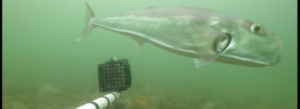Taking a New Look at Hard Bottoms on Florida’s Tampa Bay
from The Fishing Wire

Although Tampa Bay doesn’t have colorful, high-relief coral reefs like the Florida Keys, it does have areas of fossilized corals, limestone outcroppings, rubble and artificial reefs, collectively known as “hard bottom.” In fact, research from the Florida Fish and Wildlife Conservation Commission (FWC) is showing these rare habitats may serve as a critically important stop-off for juvenile fish as they graduate from nursery areas in the bay to offshore habitats in the Gulf.
“Hard bottoms are known hot spots for algae, fish and invertebrates,” said Kerry Flaherty-Walia, a researcher with the FWC. “We’ve known how productive they are in offshore areas, but new technology has helped us identify which fish are using them in Tampa Bay.”
FWC’s Fisheries Independent Monitoring Program has been sampling fish populations in Tampa Bay since 1989, documenting species and size in different parts of the bay. The new research, funded through the Tampa Bay Environmental Restoration Fund, uses video technology and high-tech fishing apparatus rather than the traditional seine nets to document what species are utilizing specific habitats.
Using the new methods, scientists have documented 19 fish species in quantities equal to or greater than captured in nets over the past 21 years, including three species never seen before in Tampa Bay and 11 that were rarely observed. The results also reflect a dramatic increase in the total number of fish documented, with significantly less effort: 64 stations measured in this study vs. 337 net hauls.
“We found fish in quantities equal or higher than we’d ever seen in the net sampling – including red grouper, grunts, Atlantic tarpon, gray snapper, gag grouper and black sea bass,” Flaherty-Walia said. “We even found snook, which was interesting because we knew it was in the bay but not necessarily using hard bottom habitat. Grunts large enough to be reproducing also were found.”
Researchers used two GoPro video cameras, mounted on a PVC frame with a bait box to attract fish, that were dropped on hard bottom habitat for 20 minutes. Dual cameras provided “stereo” vision allowing researchers to identify fish as well as their size without capturing them.
Immediately after the cameras were retrieved, hook-and-line fishing gear was deployed in the same area on timed intervals to minimize the impact of an individual angler’s skill to collect additional data from the fish that can’t be collected looking at videos or pictures.
Pinfish and a stingray also share hard bottom habitat.
The two-year project, which will continue through 2018, is an extension of TBEP’s focus on hard bottom habitat as a valuable and rare resource in need of special attention. The information collected will be used to inform strategies for better managing and protecting hard bottom in the bay, said Maya Burke, science policy coordinator for TBEP. “We’re working with the (Southwest Florida) Water Management District, Pinellas County, and the Environmental Protection Commission of Hillsborough County to identify where these habitats, including submerged rock or rubble reefs and limestone ledges, occur. Some areas are even hard to see on side-scan sonar and require video confirmation. That makes the mapping so labor-intensive that we can only do portions of the bay at a time.”
And because the hard bottoms often have very low relief, they may be covered (or uncovered) by sand during heavy storms. “If we can’t see them anymore, we need to be able to know where they’re likely to persist,” Burke adds. Like much of the bay, hard bottom habitat and the organisms that live there are threatened by direct damage from fishing gear or other physical impacts, stress and disease, and invasive species.
The time is ripe for studying hard bottom habitat in Tampa Bay. Last summer Florida Department of Environmental Protection (DEP) staff began a monitoring program, to better understand how these habitats change over time. These hard bottom habitats have a complex network of organisms that attach to and live there.
“We have historic snapshots of hard bottom — like the Environmental Protection Commision of Hillsborough County’s report on benthic invertebrates on artificial reefs — but this important monitoring work will aid in the understanding of these habitats,” Burke said.